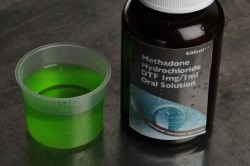Methadone’s use as an opiate addiction treatment offers a range of benefits for people recovering from long-term addiction problems. First introduced in the 1930s as a pain relief alternative to morphine, further research into the drug’s effects uncovered its ability to help recovering addicts better manage drug cravings. Since that time, methadone has become a standard drug treatment approach.
As with any treatment drug, methadone pros and cons do exist. For some people the pros outweigh the cons, while others may be better off trying another treatment approach.
Breaking down methadone’s pros and cons entails understanding how the drug works as well as the range of effects it can produce. From there, anyone considering this treatment approach will have to weigh methadone pros and cons based on his or her individual circumstances and treatment needs.
Methadone’s Mechanism of Action

Methadone is used for the treatment of opiate addiction.
Methadone is a synthetically-made opiate drug, which is part of the reason why methadone works so well as an opiate addiction treatment. In effect, methadone acts as a type of replacement therapy, mimicking the effects of harmful opiates and thereby relieving withdrawal and cravings symptoms, according to the National Institutes of Health.
While effective as a treatment drug, methadone pros and cons call into question the long-term effects of the drug on the brain. As with any other type of opiate drug, the brain can become dependent on methadone’s effects making it extremely difficult to stop methadone treatment.
Methadone also produces slow-acting effects, which makes it difficult to calibrate the correct dosage level during the early stages of treatment.
Methadone Uses
Methadone can be used for both detox and long-term maintenance purposes. As a detox treatment, methadone helps relieve much of the discomfort associated with withdrawal while also reducing the rampant drug cravings addicts experience. More oftentimes than not, these adverse effects prevent addicts from making it through the detox stage of recovery.
As a long-term maintenance therapy, methadone’s effects address the same two obstacles that make it so hard to stop using: withdrawal aftereffects and drug cravings. While methadone does a good job at relieving these effects, people who enter into methadone maintenance treatment may experience a range of adverse effects during the early stages of treatment.
Methadone pros and cons run tit-for-tat when it comes to finding the right dosage level at the start of maintenance treatment. Too high a dose leaves a person in a sedated stated, while too low a dose leaves him or her open to experiencing unwanted withdrawal and cravings effects.
From this vantage point, methadone pros and cons can work for or against the recovering addict depending on his or her level of motivation to get well. For these reasons, it’s especially important to stay in close communication with the prescribing doctor to avoid an untimely relapse episode.
Considerations
For people coming off chronic, long-term opiate addictions, the aftereffects of opiate abuse can make it all but impossible to maintain abstinence on a long-term basis. When considering methadone pros and cons, it helps to keep in mind that people with severe addiction problems require some form of medication treatment in order to overcome the effects of the drug in recovery.